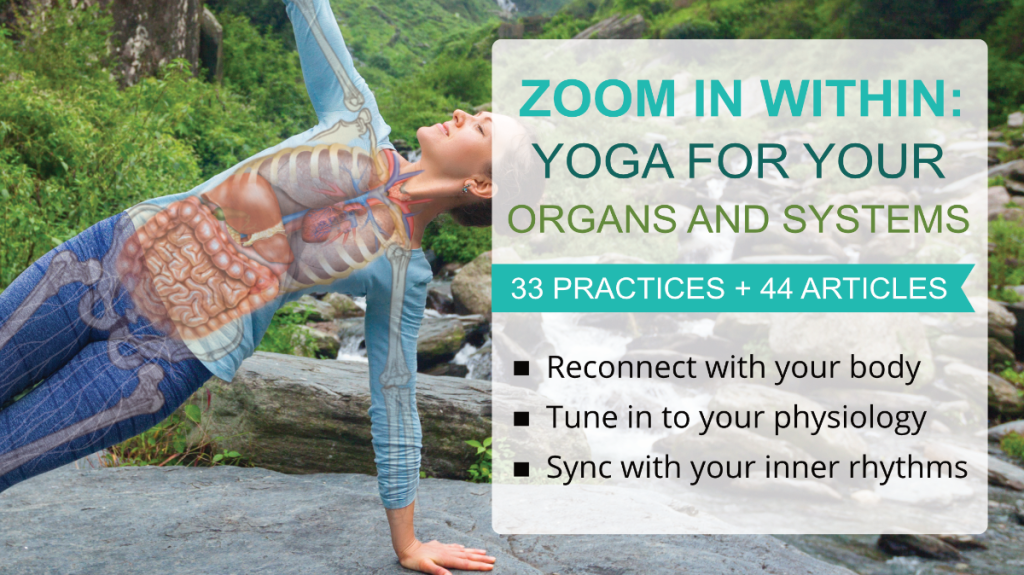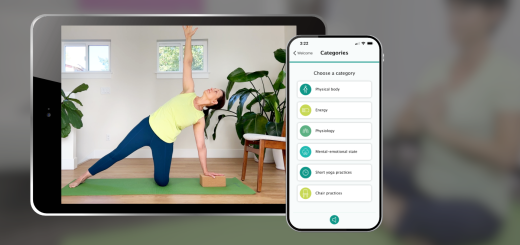Zoom in Within: Yoga for Your Organs and Systems
0Your body consists of about 37 trillion cells; each of those cells knows exactly what to do to keep you alive and healthy. Together they perform an unquantifiable number of tasks in almost perfect harmony. In the five seconds it took you to read this paragraph, your body has made more than ten million blood cells that are now speeding through your body, carrying oxygen to different tissues. The amount of work it takes to keep your body working is simply astonishing, so it’s a good thing that it’s happening “under the hood,” well below the level of our conscious awareness.
We don’t have to make decisions or set an agenda for every cell, but the very complexity of it all and the fact that we do not have much control over it can make us feel powerless when something goes wrong with our heart, lungs, liver, bones, immunity, and so on. All of a sudden, the body that’s been quietly and reliably humming along might feel foreign and hostile. If we go to see a doctor, we will probably get some version of the “eat better, exercise more, here is a pill, let’s schedule surgery” answer. Eating better and moving more is certainly helpful; medication and surgery might be necessary, but it is not empowering. How do we recover some sense of control and trust in the body?
One way to do it is to learn more about the malfunctioning system and evaluate it through a yogic or an Ayurvedic lens. Since yoga and Ayurveda concern themselves with the movement of energy and nourishment throughout the system, they look at the entire human system more holistically and offer remedies that promote overall system balance rather than “fixing that one thing”. For example, your doctor might not see a connection between your habitual breath-holding and chronic constipation, but a yoga therapist might look at it as your body’s inability to let go of things and offer practices and activities to facilitate that process. Looking at the issues holistically allows us to see bigger patterns of imbalance and choose strategies to correct them. Yoga and Ayurveda teach us that our choices matter, and we can fine-tune our physiological systems by tweaking the six main factors in our lives – diet, environment, lifestyle, exercise, breathing techniques, and mental practices. That’s empowering.
Both yoga and Ayurveda also take into account your innate constitutional traits when evaluating a condition and creating a plan of action. For example, your doctor might interpret your faster-than-normal heart rate as a sign of being deconditioned, while your Ayurvedic practitioner might explain it as a normal feature of your Vata constitutional type.
Neither the Western nor Eastern approach is superior or inferior. Think of it this way: If I asked you to draw a coffee mug, you could come up with something like this.
If I asked you to be more creative, you might produce one of those.

But almost no one would draw a coffee mug like this, a view from above, even though this angle is familiar to all of us.

However, viewing the mug from this angle can give us useful information; for example, how much coffee is left, how much milk you’ve added, etc. Viewing familiar things from different angles can give us interesting perspectives and make us connect the dots in a way that was not possible before.
This is exactly what we do in our newly released video series Zoom in Within: Yoga for Your Organs and Systems. In this series, we will explore several layers of our physiology: skeletal, respiratory, digestive, immune, cardiovascular, and nervous systems to develop a better theoretical understanding and intuitive awareness of what’s going on “under the hood.” We will view each physiological system through three different lenses:
- Structure and function (the Western science lens). We will discuss the major players (organs and tissues) within each physiological system and their function. We will also highlight what can go wrong and how we can try to prevent it with the choices we make.
- Movement of nourishment (the Yogic lens): We will follow the movement of energy throughout the system to observe the patterns of imbalance and common themes between different systems to see the full picture.
- Individual characteristics and predispositions (the Ayurvedic lens): We will analyze how your inborn constitution affects your predisposition to certain diseases and imbalances and the actions you can take to correct the imbalances and live more attuned to your natural rhythms.

In the Zoom in Within: Yoga for Your Organs and Systems series, you will get:
- 33 targeted yoga practices to support different physiological layers of our functioning
- 44 articles on various aspects of each physiological system (skeletal, respiratory, digestive, immune, cardiovascular, and nervous), as well as Yogic and Ayurvedic approaches to physiology, in printable pdf format
- 12 videos with a brief outline of the most important points for each chapter.
In this yoga series, you will learn how to tune into your physiology and learn to better interpret its signals. You will use different yogic tools to bring energy and attention to different layers of your system, help you better understand your current issues, and move you toward restoring your inner equilibrium.
Here is a short video that gives you the series overview.
The Zoom in Within: Yoga for Your Organs and Systems series is currently available on HappyU hub for a special introductory price of $45 (till December 1, 2022). You can do the practices included in this series in order or pick and choose the ones you need most. Please check it out!



















